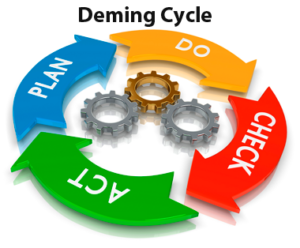W. Edwards Deming in the 1950’s proposed that business processes should be analyzed and measured to identify sources of variations that cause products to deviate from customer requirements. The Deming cycle is a continuous quality improvement model which consists of a logical sequence of four key stages: Plan, Do, Study, and Act.
Plan, Do, Study, and Act

Plan: Establish the objectives and predict the result. Plan ahead to deliver results in accordance with the expected output (the target or goals).
- Understand your definition of quality.
- How do you know if a change is an improvement?
- Can you predict your outcomes?
Do: Implement the plan, execute the plan by taking small steps in controlled circumstances and make the product. Collect data for charting and analysis in the following check and act steps.
- Start with small scale testing.
- Implement iterative changes to your experiments to test variables.
- Document every step.
Check: Study the actual results (measured and collected in do phase above) and compare against the expected results (targets or goals from the plan phase) to ascertain any differences.
- Did your outcomes match with your predictions?
- In what ways did the outcomes differ and why?
- How could you test variables which were previously unaccounted for?
Act: Take action to standardize or improve the process.
- Implement your recommended changes
- Track performance and data over time
- Provide all documentation to the company to improve internal theory
Deming Cycle vs Scrum
There are 4 Agile Core Values and 12 Principle. PDCA can be mapped to Scrum events
- Plan – iteration planning/definition of acceptance tests.
- Do – day-to-day iteration execution.
- Check – verification of results using acceptance tests.
- Act – retrospectives and subsequent planning.
There are many benefits of short-term increments:
- Smaller, bite-sized tasks provide a smaller check frequency interval.
- The progression can be evaluated more closely, and assistance can be given if the tasks fail to complete on schedule.
- The ideas can run through testing after a shorter interval after a smaller percentage is completed rather than waiting for the entire process to end.
- It gives a proper detail about what, who, when, where, and how everything is working out.
- The chances of successful completion are higher.
Benefits of the Deming cycle
- Daily routine management-for the individual and/or the team
- Problem-solving process
- Project management
- Continuous development
- Vendor development
- Human resources development
- New product development
- Process trials
Scrum Guide: Click Here Agile Blog: Click Here
Recommended Practice Exams
- Scrum.org
- PSM I – PSM Practice Exam Real Mode Questions
- PSM I – PSM Practice Exam Practice Mode Questions
- PSM II – PSM II Practice Exam Practice Mode Questions
- PSPO I – PSPO Practice Exam Real Mode Questions
- PSPO I – PSPO Practice Exam Practice Mode Questions
- PSPO II – PSPO II Practice Exam Practice Mode Questions
- PSD – PSD Practice Exam Practice Mode Questions
- SPS – SPS Practice Exam Practice Mode Questions
- Scrum Alliance
- PMI
